Sociology Report: Obesity in the US - Causes, Impacts, and Solutions
VerifiedAdded on 2022/09/09
|10
|3130
|20
Report
AI Summary
This sociology report delves into the multifaceted issue of obesity as a significant social problem, particularly within the United States. The report identifies obesity as a prevalent concern, highlighting its rising rates and associated health risks, including cardiovascular diseases and diabetes, while also addressing the psychological impacts such as discrimination and reduced quality of life. It explores various contributing factors, such as increased calorie intake, sedentary lifestyles, and the influence of marketing, alongside socioeconomic factors. The report further examines how obesity constitutes a social problem, affecting healthcare costs, workplace productivity, and overall societal well-being. It also explores the widespread nature of obesity across different demographics and geographical regions. Finally, the report suggests potential solutions, including the formulation of public health policies, healthcare campaigns, and lifestyle modifications, to address and mitigate the impact of obesity.
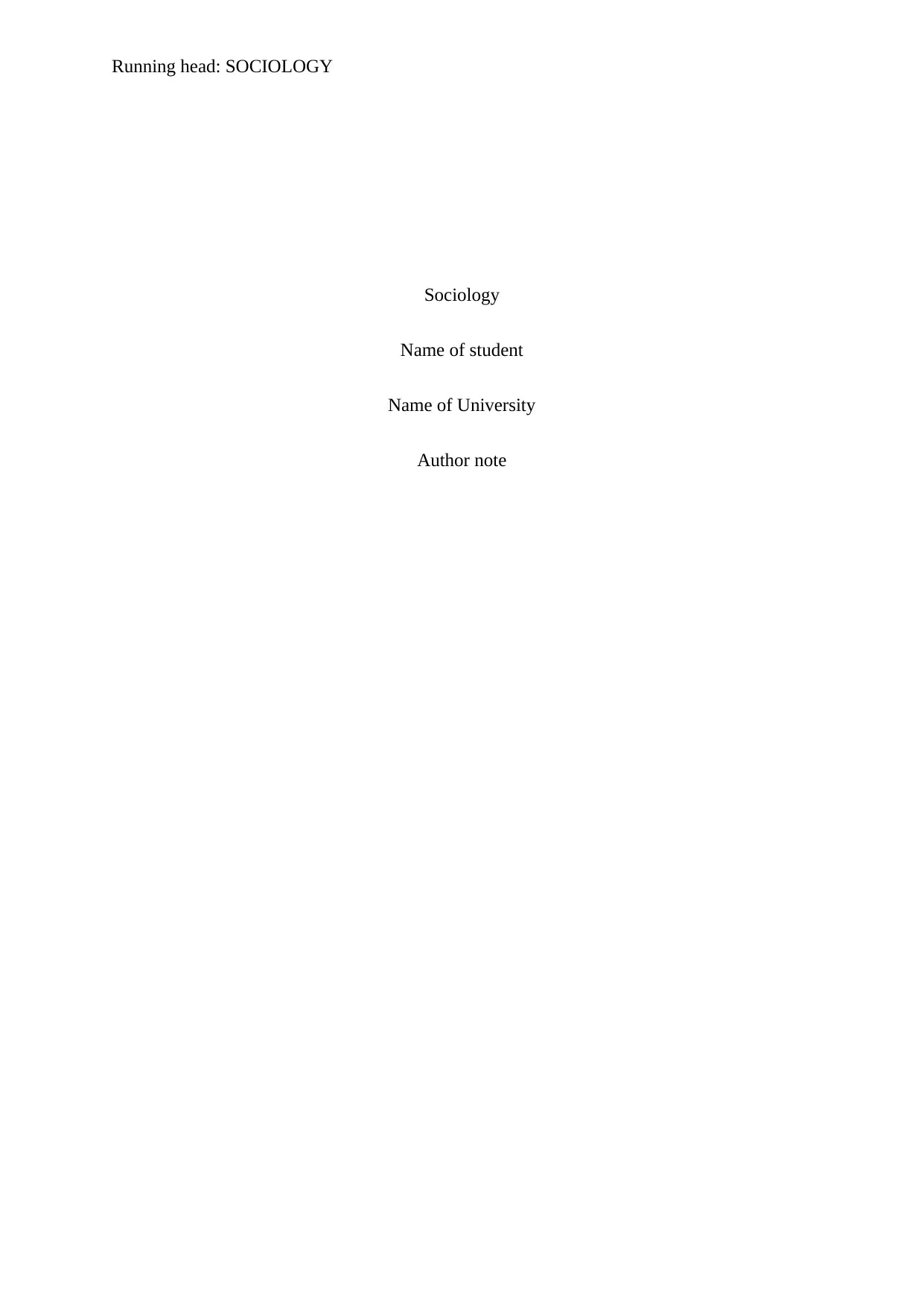
Running head: SOCIOLOGY
Sociology
Name of student
Name of University
Author note
Sociology
Name of student
Name of University
Author note
Paraphrase This Document
Need a fresh take? Get an instant paraphrase of this document with our AI Paraphraser
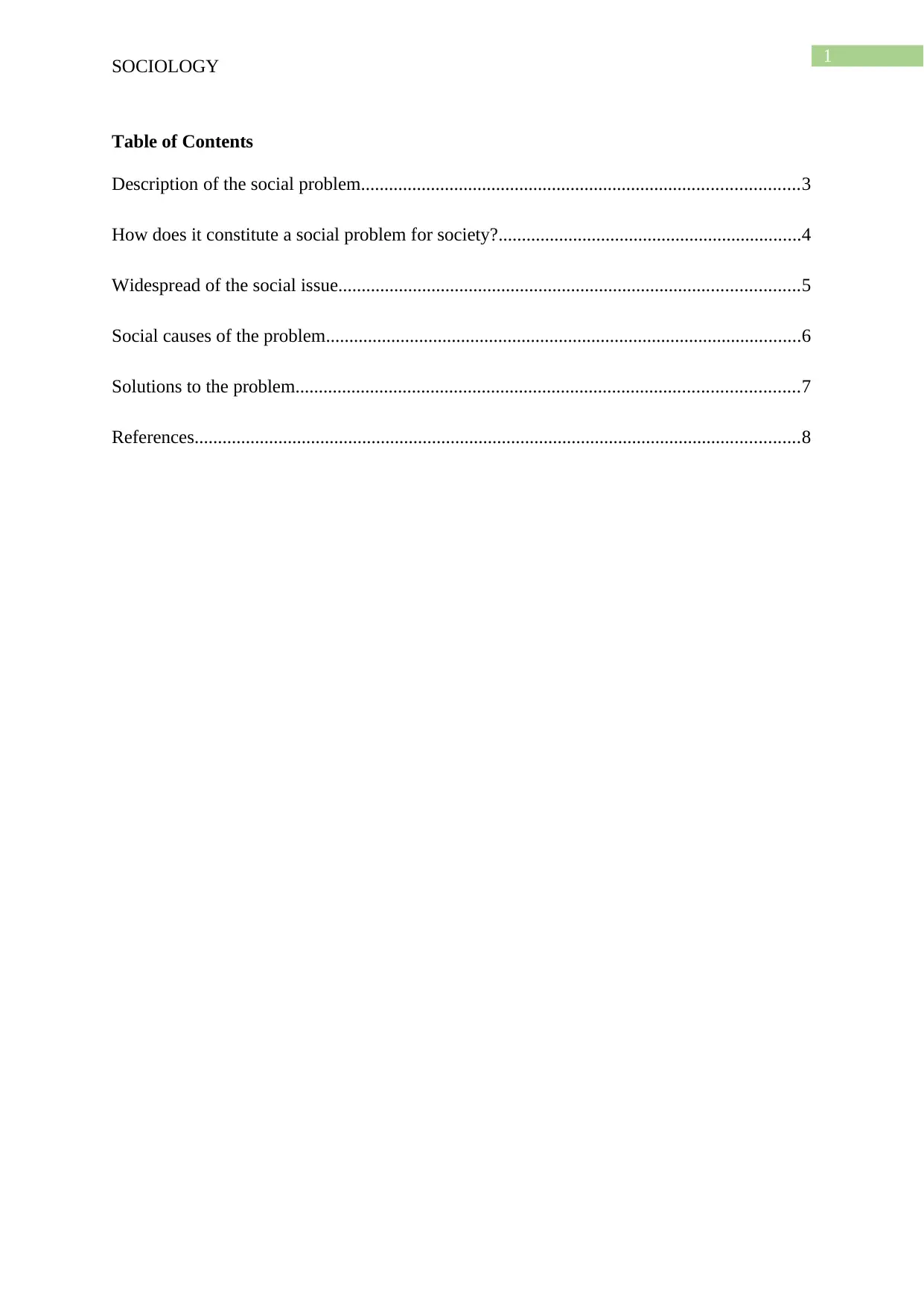
1
SOCIOLOGY
Table of Contents
Description of the social problem..............................................................................................3
How does it constitute a social problem for society?.................................................................4
Widespread of the social issue...................................................................................................5
Social causes of the problem......................................................................................................6
Solutions to the problem............................................................................................................7
References..................................................................................................................................8
SOCIOLOGY
Table of Contents
Description of the social problem..............................................................................................3
How does it constitute a social problem for society?.................................................................4
Widespread of the social issue...................................................................................................5
Social causes of the problem......................................................................................................6
Solutions to the problem............................................................................................................7
References..................................................................................................................................8
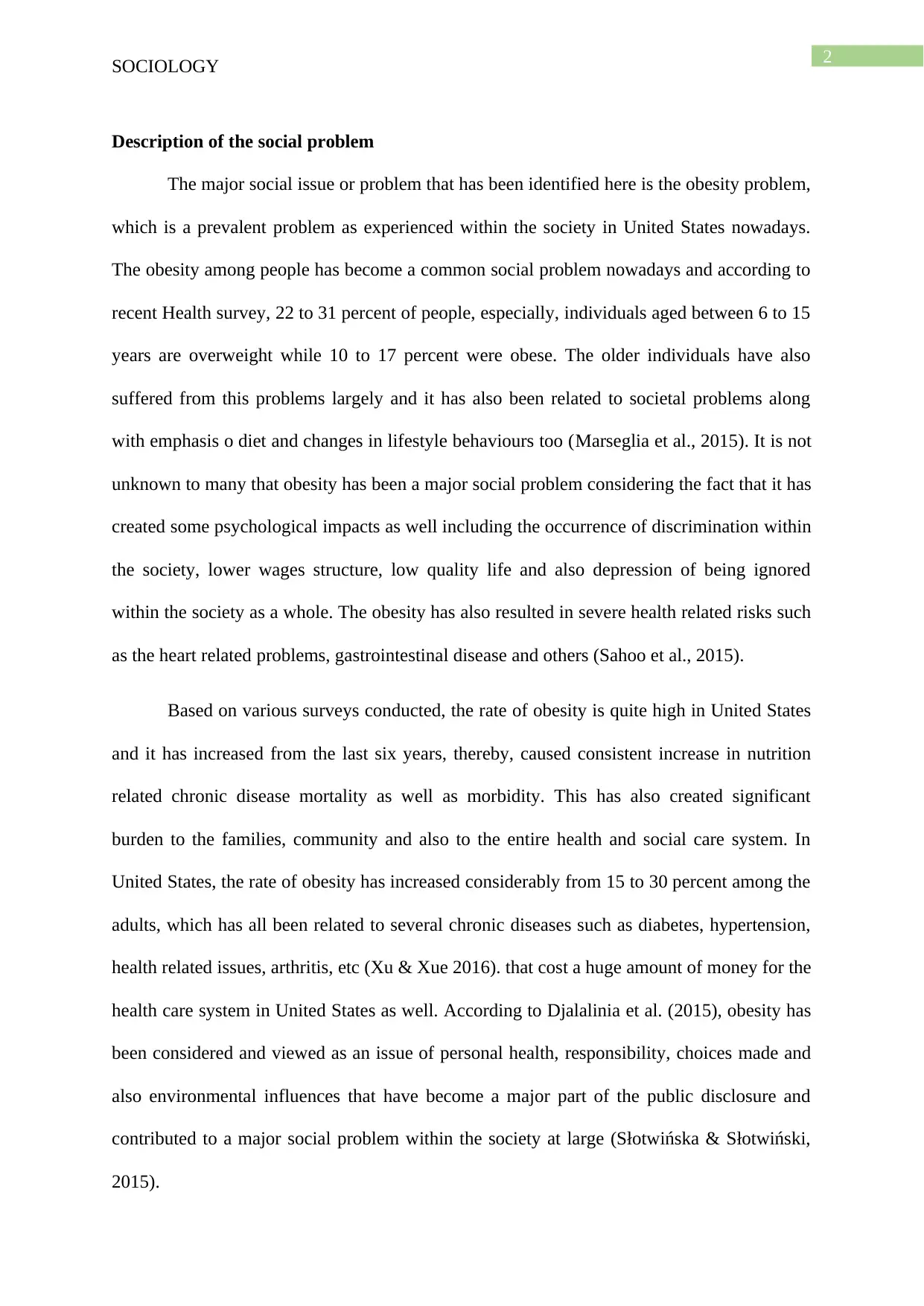
2
SOCIOLOGY
Description of the social problem
The major social issue or problem that has been identified here is the obesity problem,
which is a prevalent problem as experienced within the society in United States nowadays.
The obesity among people has become a common social problem nowadays and according to
recent Health survey, 22 to 31 percent of people, especially, individuals aged between 6 to 15
years are overweight while 10 to 17 percent were obese. The older individuals have also
suffered from this problems largely and it has also been related to societal problems along
with emphasis o diet and changes in lifestyle behaviours too (Marseglia et al., 2015). It is not
unknown to many that obesity has been a major social problem considering the fact that it has
created some psychological impacts as well including the occurrence of discrimination within
the society, lower wages structure, low quality life and also depression of being ignored
within the society as a whole. The obesity has also resulted in severe health related risks such
as the heart related problems, gastrointestinal disease and others (Sahoo et al., 2015).
Based on various surveys conducted, the rate of obesity is quite high in United States
and it has increased from the last six years, thereby, caused consistent increase in nutrition
related chronic disease mortality as well as morbidity. This has also created significant
burden to the families, community and also to the entire health and social care system. In
United States, the rate of obesity has increased considerably from 15 to 30 percent among the
adults, which has all been related to several chronic diseases such as diabetes, hypertension,
health related issues, arthritis, etc (Xu & Xue 2016). that cost a huge amount of money for the
health care system in United States as well. According to Djalalinia et al. (2015), obesity has
been considered and viewed as an issue of personal health, responsibility, choices made and
also environmental influences that have become a major part of the public disclosure and
contributed to a major social problem within the society at large (Słotwińska & Słotwiński,
2015).
SOCIOLOGY
Description of the social problem
The major social issue or problem that has been identified here is the obesity problem,
which is a prevalent problem as experienced within the society in United States nowadays.
The obesity among people has become a common social problem nowadays and according to
recent Health survey, 22 to 31 percent of people, especially, individuals aged between 6 to 15
years are overweight while 10 to 17 percent were obese. The older individuals have also
suffered from this problems largely and it has also been related to societal problems along
with emphasis o diet and changes in lifestyle behaviours too (Marseglia et al., 2015). It is not
unknown to many that obesity has been a major social problem considering the fact that it has
created some psychological impacts as well including the occurrence of discrimination within
the society, lower wages structure, low quality life and also depression of being ignored
within the society as a whole. The obesity has also resulted in severe health related risks such
as the heart related problems, gastrointestinal disease and others (Sahoo et al., 2015).
Based on various surveys conducted, the rate of obesity is quite high in United States
and it has increased from the last six years, thereby, caused consistent increase in nutrition
related chronic disease mortality as well as morbidity. This has also created significant
burden to the families, community and also to the entire health and social care system. In
United States, the rate of obesity has increased considerably from 15 to 30 percent among the
adults, which has all been related to several chronic diseases such as diabetes, hypertension,
health related issues, arthritis, etc (Xu & Xue 2016). that cost a huge amount of money for the
health care system in United States as well. According to Djalalinia et al. (2015), obesity has
been considered and viewed as an issue of personal health, responsibility, choices made and
also environmental influences that have become a major part of the public disclosure and
contributed to a major social problem within the society at large (Słotwińska & Słotwiński,
2015).
⊘ This is a preview!⊘
Do you want full access?
Subscribe today to unlock all pages.

Trusted by 1+ million students worldwide
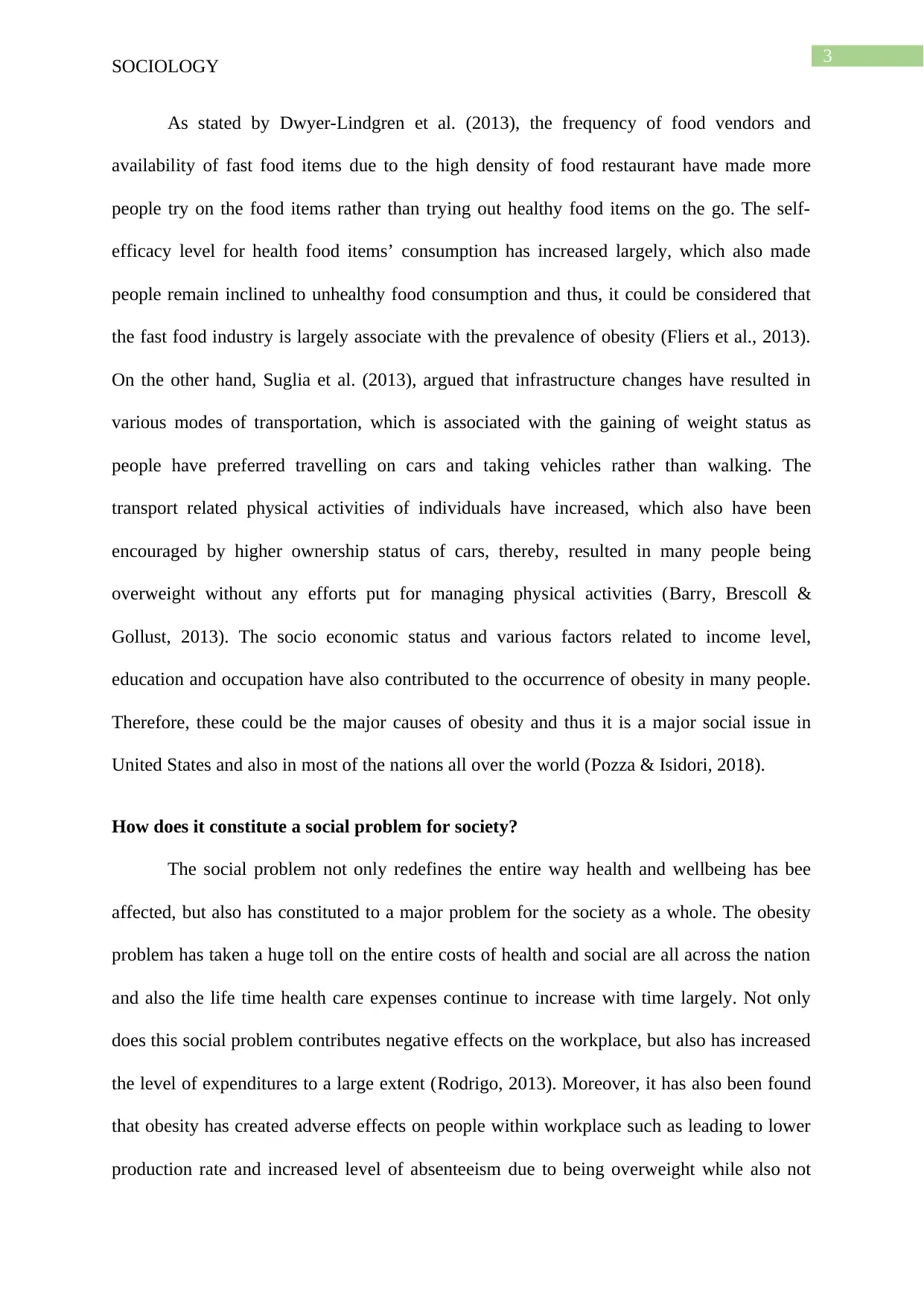
3
SOCIOLOGY
As stated by Dwyer-Lindgren et al. (2013), the frequency of food vendors and
availability of fast food items due to the high density of food restaurant have made more
people try on the food items rather than trying out healthy food items on the go. The self-
efficacy level for health food items’ consumption has increased largely, which also made
people remain inclined to unhealthy food consumption and thus, it could be considered that
the fast food industry is largely associate with the prevalence of obesity (Fliers et al., 2013).
On the other hand, Suglia et al. (2013), argued that infrastructure changes have resulted in
various modes of transportation, which is associated with the gaining of weight status as
people have preferred travelling on cars and taking vehicles rather than walking. The
transport related physical activities of individuals have increased, which also have been
encouraged by higher ownership status of cars, thereby, resulted in many people being
overweight without any efforts put for managing physical activities (Barry, Brescoll &
Gollust, 2013). The socio economic status and various factors related to income level,
education and occupation have also contributed to the occurrence of obesity in many people.
Therefore, these could be the major causes of obesity and thus it is a major social issue in
United States and also in most of the nations all over the world (Pozza & Isidori, 2018).
How does it constitute a social problem for society?
The social problem not only redefines the entire way health and wellbeing has bee
affected, but also has constituted to a major problem for the society as a whole. The obesity
problem has taken a huge toll on the entire costs of health and social are all across the nation
and also the life time health care expenses continue to increase with time largely. Not only
does this social problem contributes negative effects on the workplace, but also has increased
the level of expenditures to a large extent (Rodrigo, 2013). Moreover, it has also been found
that obesity has created adverse effects on people within workplace such as leading to lower
production rate and increased level of absenteeism due to being overweight while also not
SOCIOLOGY
As stated by Dwyer-Lindgren et al. (2013), the frequency of food vendors and
availability of fast food items due to the high density of food restaurant have made more
people try on the food items rather than trying out healthy food items on the go. The self-
efficacy level for health food items’ consumption has increased largely, which also made
people remain inclined to unhealthy food consumption and thus, it could be considered that
the fast food industry is largely associate with the prevalence of obesity (Fliers et al., 2013).
On the other hand, Suglia et al. (2013), argued that infrastructure changes have resulted in
various modes of transportation, which is associated with the gaining of weight status as
people have preferred travelling on cars and taking vehicles rather than walking. The
transport related physical activities of individuals have increased, which also have been
encouraged by higher ownership status of cars, thereby, resulted in many people being
overweight without any efforts put for managing physical activities (Barry, Brescoll &
Gollust, 2013). The socio economic status and various factors related to income level,
education and occupation have also contributed to the occurrence of obesity in many people.
Therefore, these could be the major causes of obesity and thus it is a major social issue in
United States and also in most of the nations all over the world (Pozza & Isidori, 2018).
How does it constitute a social problem for society?
The social problem not only redefines the entire way health and wellbeing has bee
affected, but also has constituted to a major problem for the society as a whole. The obesity
problem has taken a huge toll on the entire costs of health and social are all across the nation
and also the life time health care expenses continue to increase with time largely. Not only
does this social problem contributes negative effects on the workplace, but also has increased
the level of expenditures to a large extent (Rodrigo, 2013). Moreover, it has also been found
that obesity has created adverse effects on people within workplace such as leading to lower
production rate and increased level of absenteeism due to being overweight while also not
Paraphrase This Document
Need a fresh take? Get an instant paraphrase of this document with our AI Paraphraser
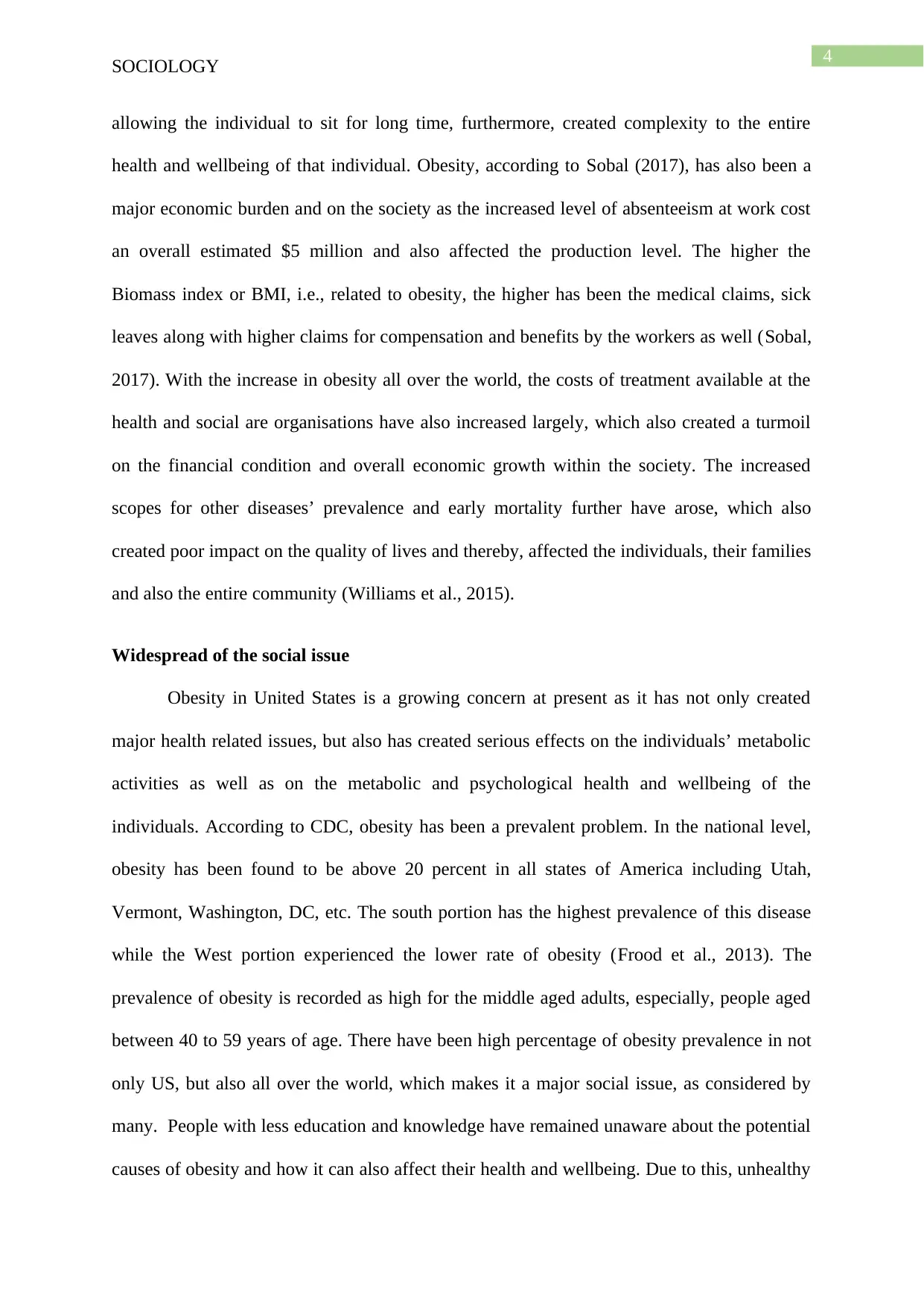
4
SOCIOLOGY
allowing the individual to sit for long time, furthermore, created complexity to the entire
health and wellbeing of that individual. Obesity, according to Sobal (2017), has also been a
major economic burden and on the society as the increased level of absenteeism at work cost
an overall estimated $5 million and also affected the production level. The higher the
Biomass index or BMI, i.e., related to obesity, the higher has been the medical claims, sick
leaves along with higher claims for compensation and benefits by the workers as well (Sobal,
2017). With the increase in obesity all over the world, the costs of treatment available at the
health and social are organisations have also increased largely, which also created a turmoil
on the financial condition and overall economic growth within the society. The increased
scopes for other diseases’ prevalence and early mortality further have arose, which also
created poor impact on the quality of lives and thereby, affected the individuals, their families
and also the entire community (Williams et al., 2015).
Widespread of the social issue
Obesity in United States is a growing concern at present as it has not only created
major health related issues, but also has created serious effects on the individuals’ metabolic
activities as well as on the metabolic and psychological health and wellbeing of the
individuals. According to CDC, obesity has been a prevalent problem. In the national level,
obesity has been found to be above 20 percent in all states of America including Utah,
Vermont, Washington, DC, etc. The south portion has the highest prevalence of this disease
while the West portion experienced the lower rate of obesity (Frood et al., 2013). The
prevalence of obesity is recorded as high for the middle aged adults, especially, people aged
between 40 to 59 years of age. There have been high percentage of obesity prevalence in not
only US, but also all over the world, which makes it a major social issue, as considered by
many. People with less education and knowledge have remained unaware about the potential
causes of obesity and how it can also affect their health and wellbeing. Due to this, unhealthy
SOCIOLOGY
allowing the individual to sit for long time, furthermore, created complexity to the entire
health and wellbeing of that individual. Obesity, according to Sobal (2017), has also been a
major economic burden and on the society as the increased level of absenteeism at work cost
an overall estimated $5 million and also affected the production level. The higher the
Biomass index or BMI, i.e., related to obesity, the higher has been the medical claims, sick
leaves along with higher claims for compensation and benefits by the workers as well (Sobal,
2017). With the increase in obesity all over the world, the costs of treatment available at the
health and social are organisations have also increased largely, which also created a turmoil
on the financial condition and overall economic growth within the society. The increased
scopes for other diseases’ prevalence and early mortality further have arose, which also
created poor impact on the quality of lives and thereby, affected the individuals, their families
and also the entire community (Williams et al., 2015).
Widespread of the social issue
Obesity in United States is a growing concern at present as it has not only created
major health related issues, but also has created serious effects on the individuals’ metabolic
activities as well as on the metabolic and psychological health and wellbeing of the
individuals. According to CDC, obesity has been a prevalent problem. In the national level,
obesity has been found to be above 20 percent in all states of America including Utah,
Vermont, Washington, DC, etc. The south portion has the highest prevalence of this disease
while the West portion experienced the lower rate of obesity (Frood et al., 2013). The
prevalence of obesity is recorded as high for the middle aged adults, especially, people aged
between 40 to 59 years of age. There have been high percentage of obesity prevalence in not
only US, but also all over the world, which makes it a major social issue, as considered by
many. People with less education and knowledge have remained unaware about the potential
causes of obesity and how it can also affect their health and wellbeing. Due to this, unhealthy
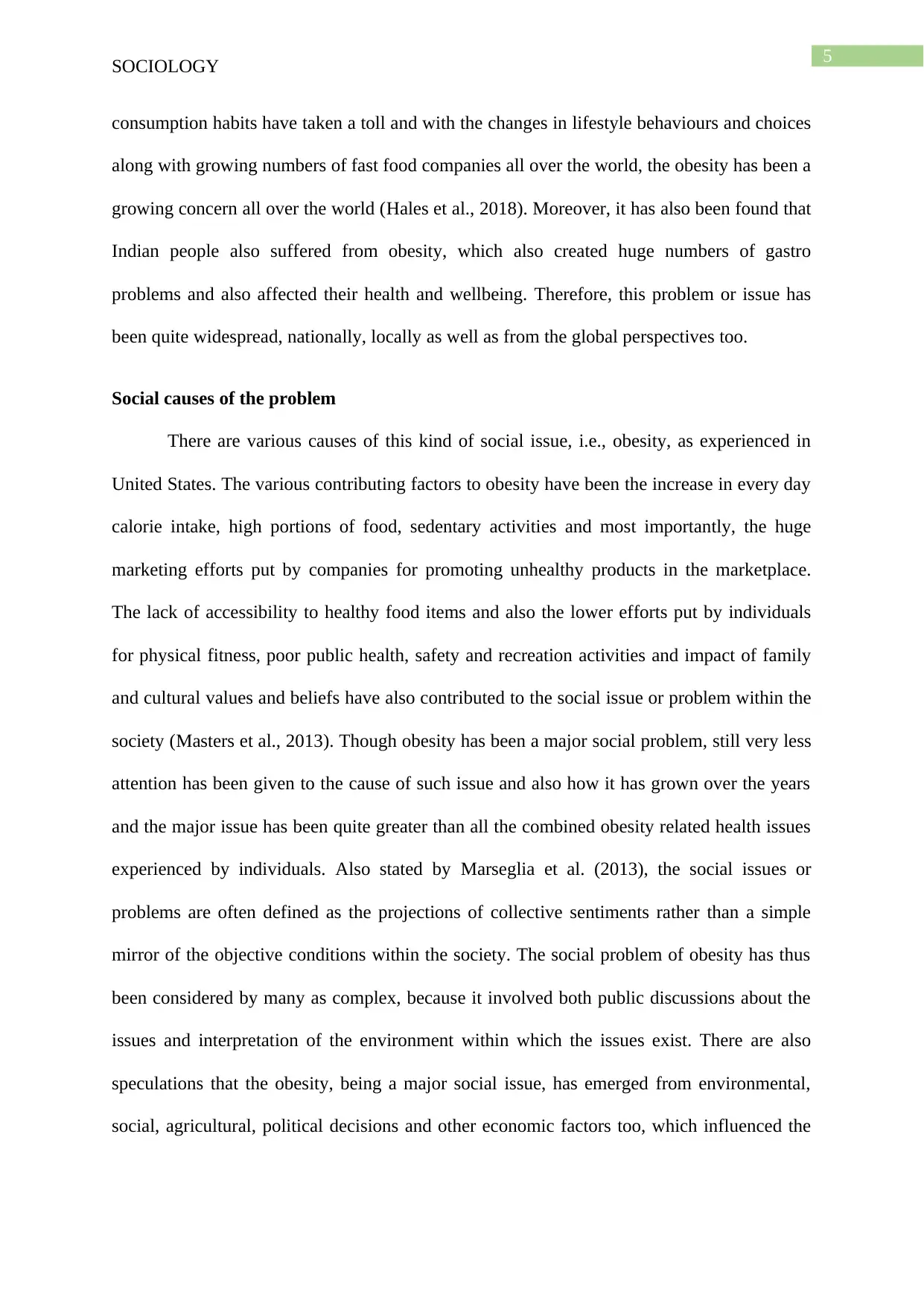
5
SOCIOLOGY
consumption habits have taken a toll and with the changes in lifestyle behaviours and choices
along with growing numbers of fast food companies all over the world, the obesity has been a
growing concern all over the world (Hales et al., 2018). Moreover, it has also been found that
Indian people also suffered from obesity, which also created huge numbers of gastro
problems and also affected their health and wellbeing. Therefore, this problem or issue has
been quite widespread, nationally, locally as well as from the global perspectives too.
Social causes of the problem
There are various causes of this kind of social issue, i.e., obesity, as experienced in
United States. The various contributing factors to obesity have been the increase in every day
calorie intake, high portions of food, sedentary activities and most importantly, the huge
marketing efforts put by companies for promoting unhealthy products in the marketplace.
The lack of accessibility to healthy food items and also the lower efforts put by individuals
for physical fitness, poor public health, safety and recreation activities and impact of family
and cultural values and beliefs have also contributed to the social issue or problem within the
society (Masters et al., 2013). Though obesity has been a major social problem, still very less
attention has been given to the cause of such issue and also how it has grown over the years
and the major issue has been quite greater than all the combined obesity related health issues
experienced by individuals. Also stated by Marseglia et al. (2013), the social issues or
problems are often defined as the projections of collective sentiments rather than a simple
mirror of the objective conditions within the society. The social problem of obesity has thus
been considered by many as complex, because it involved both public discussions about the
issues and interpretation of the environment within which the issues exist. There are also
speculations that the obesity, being a major social issue, has emerged from environmental,
social, agricultural, political decisions and other economic factors too, which influenced the
SOCIOLOGY
consumption habits have taken a toll and with the changes in lifestyle behaviours and choices
along with growing numbers of fast food companies all over the world, the obesity has been a
growing concern all over the world (Hales et al., 2018). Moreover, it has also been found that
Indian people also suffered from obesity, which also created huge numbers of gastro
problems and also affected their health and wellbeing. Therefore, this problem or issue has
been quite widespread, nationally, locally as well as from the global perspectives too.
Social causes of the problem
There are various causes of this kind of social issue, i.e., obesity, as experienced in
United States. The various contributing factors to obesity have been the increase in every day
calorie intake, high portions of food, sedentary activities and most importantly, the huge
marketing efforts put by companies for promoting unhealthy products in the marketplace.
The lack of accessibility to healthy food items and also the lower efforts put by individuals
for physical fitness, poor public health, safety and recreation activities and impact of family
and cultural values and beliefs have also contributed to the social issue or problem within the
society (Masters et al., 2013). Though obesity has been a major social problem, still very less
attention has been given to the cause of such issue and also how it has grown over the years
and the major issue has been quite greater than all the combined obesity related health issues
experienced by individuals. Also stated by Marseglia et al. (2013), the social issues or
problems are often defined as the projections of collective sentiments rather than a simple
mirror of the objective conditions within the society. The social problem of obesity has thus
been considered by many as complex, because it involved both public discussions about the
issues and interpretation of the environment within which the issues exist. There are also
speculations that the obesity, being a major social issue, has emerged from environmental,
social, agricultural, political decisions and other economic factors too, which influenced the
⊘ This is a preview!⊘
Do you want full access?
Subscribe today to unlock all pages.

Trusted by 1+ million students worldwide
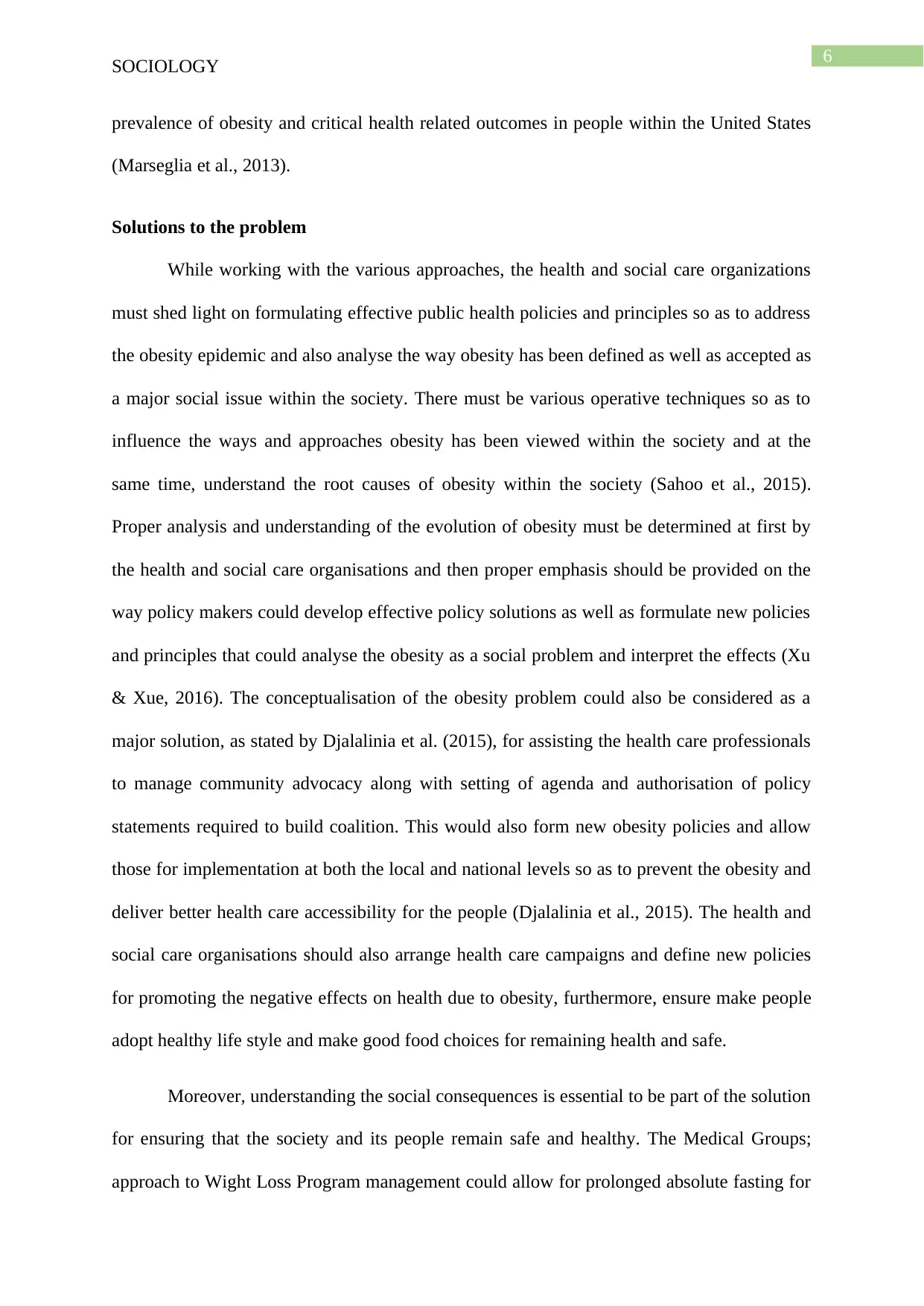
6
SOCIOLOGY
prevalence of obesity and critical health related outcomes in people within the United States
(Marseglia et al., 2013).
Solutions to the problem
While working with the various approaches, the health and social care organizations
must shed light on formulating effective public health policies and principles so as to address
the obesity epidemic and also analyse the way obesity has been defined as well as accepted as
a major social issue within the society. There must be various operative techniques so as to
influence the ways and approaches obesity has been viewed within the society and at the
same time, understand the root causes of obesity within the society (Sahoo et al., 2015).
Proper analysis and understanding of the evolution of obesity must be determined at first by
the health and social care organisations and then proper emphasis should be provided on the
way policy makers could develop effective policy solutions as well as formulate new policies
and principles that could analyse the obesity as a social problem and interpret the effects (Xu
& Xue, 2016). The conceptualisation of the obesity problem could also be considered as a
major solution, as stated by Djalalinia et al. (2015), for assisting the health care professionals
to manage community advocacy along with setting of agenda and authorisation of policy
statements required to build coalition. This would also form new obesity policies and allow
those for implementation at both the local and national levels so as to prevent the obesity and
deliver better health care accessibility for the people (Djalalinia et al., 2015). The health and
social care organisations should also arrange health care campaigns and define new policies
for promoting the negative effects on health due to obesity, furthermore, ensure make people
adopt healthy life style and make good food choices for remaining health and safe.
Moreover, understanding the social consequences is essential to be part of the solution
for ensuring that the society and its people remain safe and healthy. The Medical Groups;
approach to Wight Loss Program management could allow for prolonged absolute fasting for
SOCIOLOGY
prevalence of obesity and critical health related outcomes in people within the United States
(Marseglia et al., 2013).
Solutions to the problem
While working with the various approaches, the health and social care organizations
must shed light on formulating effective public health policies and principles so as to address
the obesity epidemic and also analyse the way obesity has been defined as well as accepted as
a major social issue within the society. There must be various operative techniques so as to
influence the ways and approaches obesity has been viewed within the society and at the
same time, understand the root causes of obesity within the society (Sahoo et al., 2015).
Proper analysis and understanding of the evolution of obesity must be determined at first by
the health and social care organisations and then proper emphasis should be provided on the
way policy makers could develop effective policy solutions as well as formulate new policies
and principles that could analyse the obesity as a social problem and interpret the effects (Xu
& Xue, 2016). The conceptualisation of the obesity problem could also be considered as a
major solution, as stated by Djalalinia et al. (2015), for assisting the health care professionals
to manage community advocacy along with setting of agenda and authorisation of policy
statements required to build coalition. This would also form new obesity policies and allow
those for implementation at both the local and national levels so as to prevent the obesity and
deliver better health care accessibility for the people (Djalalinia et al., 2015). The health and
social care organisations should also arrange health care campaigns and define new policies
for promoting the negative effects on health due to obesity, furthermore, ensure make people
adopt healthy life style and make good food choices for remaining health and safe.
Moreover, understanding the social consequences is essential to be part of the solution
for ensuring that the society and its people remain safe and healthy. The Medical Groups;
approach to Wight Loss Program management could allow for prolonged absolute fasting for
Paraphrase This Document
Need a fresh take? Get an instant paraphrase of this document with our AI Paraphraser
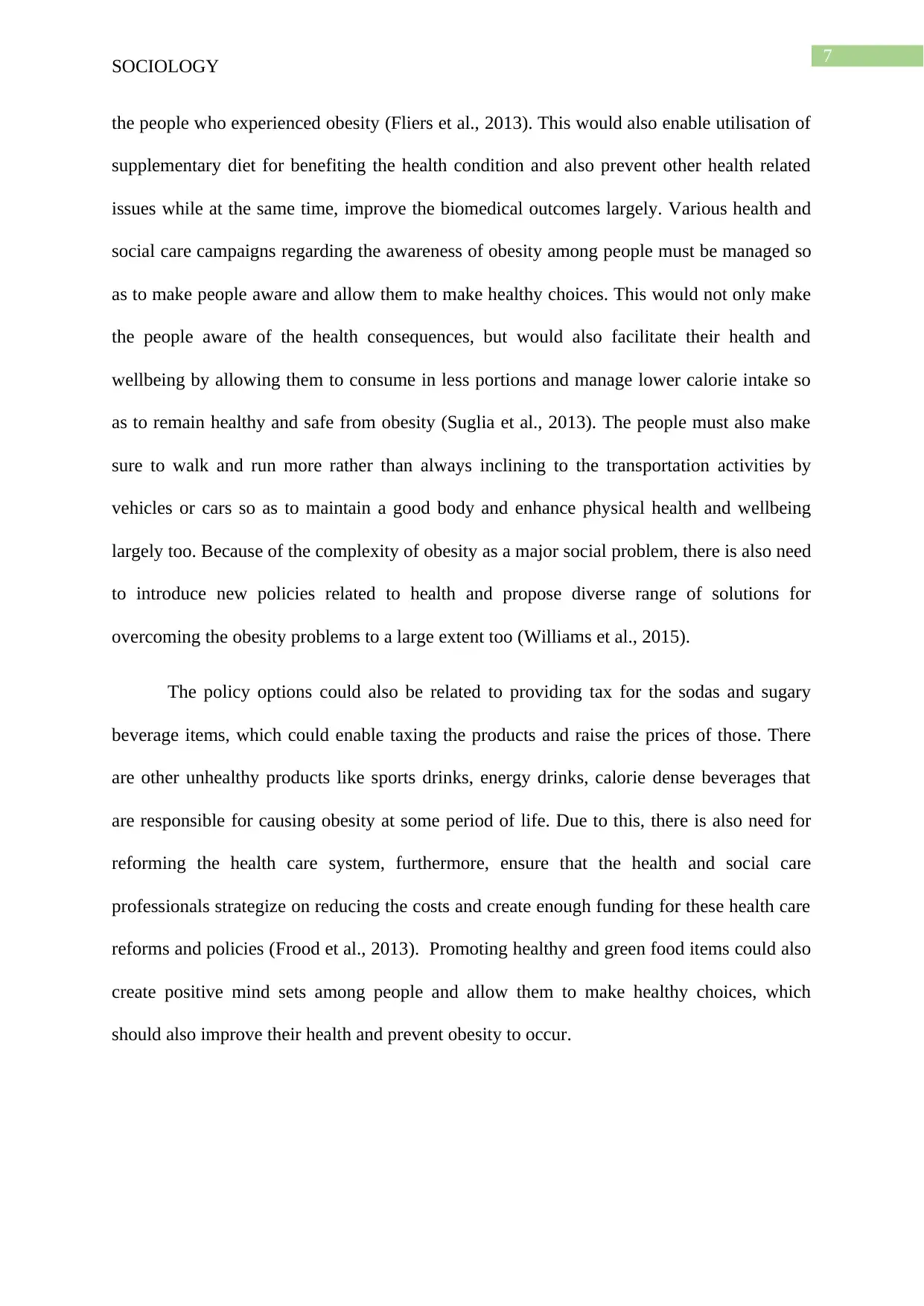
7
SOCIOLOGY
the people who experienced obesity (Fliers et al., 2013). This would also enable utilisation of
supplementary diet for benefiting the health condition and also prevent other health related
issues while at the same time, improve the biomedical outcomes largely. Various health and
social care campaigns regarding the awareness of obesity among people must be managed so
as to make people aware and allow them to make healthy choices. This would not only make
the people aware of the health consequences, but would also facilitate their health and
wellbeing by allowing them to consume in less portions and manage lower calorie intake so
as to remain healthy and safe from obesity (Suglia et al., 2013). The people must also make
sure to walk and run more rather than always inclining to the transportation activities by
vehicles or cars so as to maintain a good body and enhance physical health and wellbeing
largely too. Because of the complexity of obesity as a major social problem, there is also need
to introduce new policies related to health and propose diverse range of solutions for
overcoming the obesity problems to a large extent too (Williams et al., 2015).
The policy options could also be related to providing tax for the sodas and sugary
beverage items, which could enable taxing the products and raise the prices of those. There
are other unhealthy products like sports drinks, energy drinks, calorie dense beverages that
are responsible for causing obesity at some period of life. Due to this, there is also need for
reforming the health care system, furthermore, ensure that the health and social care
professionals strategize on reducing the costs and create enough funding for these health care
reforms and policies (Frood et al., 2013). Promoting healthy and green food items could also
create positive mind sets among people and allow them to make healthy choices, which
should also improve their health and prevent obesity to occur.
SOCIOLOGY
the people who experienced obesity (Fliers et al., 2013). This would also enable utilisation of
supplementary diet for benefiting the health condition and also prevent other health related
issues while at the same time, improve the biomedical outcomes largely. Various health and
social care campaigns regarding the awareness of obesity among people must be managed so
as to make people aware and allow them to make healthy choices. This would not only make
the people aware of the health consequences, but would also facilitate their health and
wellbeing by allowing them to consume in less portions and manage lower calorie intake so
as to remain healthy and safe from obesity (Suglia et al., 2013). The people must also make
sure to walk and run more rather than always inclining to the transportation activities by
vehicles or cars so as to maintain a good body and enhance physical health and wellbeing
largely too. Because of the complexity of obesity as a major social problem, there is also need
to introduce new policies related to health and propose diverse range of solutions for
overcoming the obesity problems to a large extent too (Williams et al., 2015).
The policy options could also be related to providing tax for the sodas and sugary
beverage items, which could enable taxing the products and raise the prices of those. There
are other unhealthy products like sports drinks, energy drinks, calorie dense beverages that
are responsible for causing obesity at some period of life. Due to this, there is also need for
reforming the health care system, furthermore, ensure that the health and social care
professionals strategize on reducing the costs and create enough funding for these health care
reforms and policies (Frood et al., 2013). Promoting healthy and green food items could also
create positive mind sets among people and allow them to make healthy choices, which
should also improve their health and prevent obesity to occur.
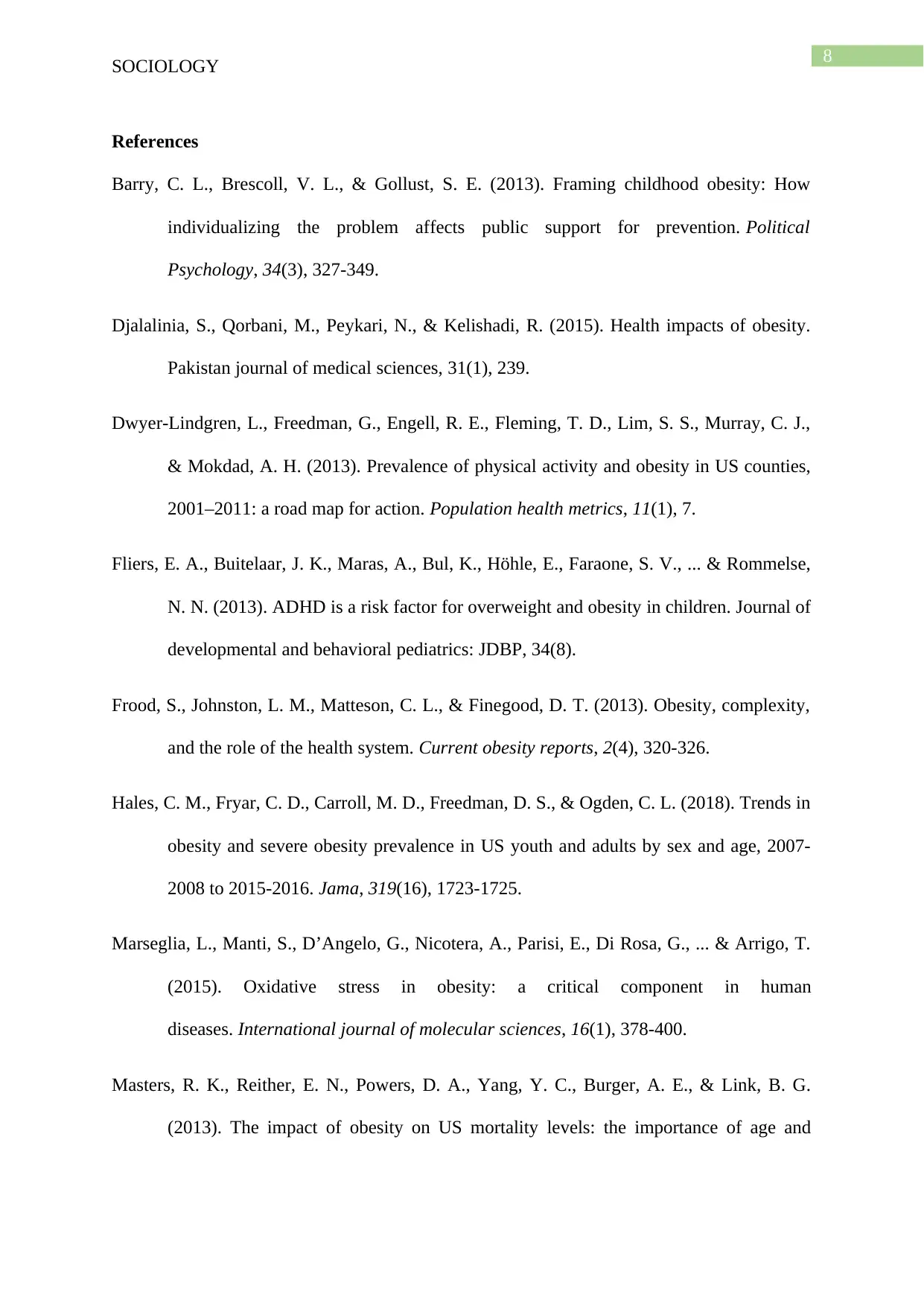
8
SOCIOLOGY
References
Barry, C. L., Brescoll, V. L., & Gollust, S. E. (2013). Framing childhood obesity: How
individualizing the problem affects public support for prevention. Political
Psychology, 34(3), 327-349.
Djalalinia, S., Qorbani, M., Peykari, N., & Kelishadi, R. (2015). Health impacts of obesity.
Pakistan journal of medical sciences, 31(1), 239.
Dwyer-Lindgren, L., Freedman, G., Engell, R. E., Fleming, T. D., Lim, S. S., Murray, C. J.,
& Mokdad, A. H. (2013). Prevalence of physical activity and obesity in US counties,
2001–2011: a road map for action. Population health metrics, 11(1), 7.
Fliers, E. A., Buitelaar, J. K., Maras, A., Bul, K., Höhle, E., Faraone, S. V., ... & Rommelse,
N. N. (2013). ADHD is a risk factor for overweight and obesity in children. Journal of
developmental and behavioral pediatrics: JDBP, 34(8).
Frood, S., Johnston, L. M., Matteson, C. L., & Finegood, D. T. (2013). Obesity, complexity,
and the role of the health system. Current obesity reports, 2(4), 320-326.
Hales, C. M., Fryar, C. D., Carroll, M. D., Freedman, D. S., & Ogden, C. L. (2018). Trends in
obesity and severe obesity prevalence in US youth and adults by sex and age, 2007-
2008 to 2015-2016. Jama, 319(16), 1723-1725.
Marseglia, L., Manti, S., D’Angelo, G., Nicotera, A., Parisi, E., Di Rosa, G., ... & Arrigo, T.
(2015). Oxidative stress in obesity: a critical component in human
diseases. International journal of molecular sciences, 16(1), 378-400.
Masters, R. K., Reither, E. N., Powers, D. A., Yang, Y. C., Burger, A. E., & Link, B. G.
(2013). The impact of obesity on US mortality levels: the importance of age and
SOCIOLOGY
References
Barry, C. L., Brescoll, V. L., & Gollust, S. E. (2013). Framing childhood obesity: How
individualizing the problem affects public support for prevention. Political
Psychology, 34(3), 327-349.
Djalalinia, S., Qorbani, M., Peykari, N., & Kelishadi, R. (2015). Health impacts of obesity.
Pakistan journal of medical sciences, 31(1), 239.
Dwyer-Lindgren, L., Freedman, G., Engell, R. E., Fleming, T. D., Lim, S. S., Murray, C. J.,
& Mokdad, A. H. (2013). Prevalence of physical activity and obesity in US counties,
2001–2011: a road map for action. Population health metrics, 11(1), 7.
Fliers, E. A., Buitelaar, J. K., Maras, A., Bul, K., Höhle, E., Faraone, S. V., ... & Rommelse,
N. N. (2013). ADHD is a risk factor for overweight and obesity in children. Journal of
developmental and behavioral pediatrics: JDBP, 34(8).
Frood, S., Johnston, L. M., Matteson, C. L., & Finegood, D. T. (2013). Obesity, complexity,
and the role of the health system. Current obesity reports, 2(4), 320-326.
Hales, C. M., Fryar, C. D., Carroll, M. D., Freedman, D. S., & Ogden, C. L. (2018). Trends in
obesity and severe obesity prevalence in US youth and adults by sex and age, 2007-
2008 to 2015-2016. Jama, 319(16), 1723-1725.
Marseglia, L., Manti, S., D’Angelo, G., Nicotera, A., Parisi, E., Di Rosa, G., ... & Arrigo, T.
(2015). Oxidative stress in obesity: a critical component in human
diseases. International journal of molecular sciences, 16(1), 378-400.
Masters, R. K., Reither, E. N., Powers, D. A., Yang, Y. C., Burger, A. E., & Link, B. G.
(2013). The impact of obesity on US mortality levels: the importance of age and
⊘ This is a preview!⊘
Do you want full access?
Subscribe today to unlock all pages.

Trusted by 1+ million students worldwide
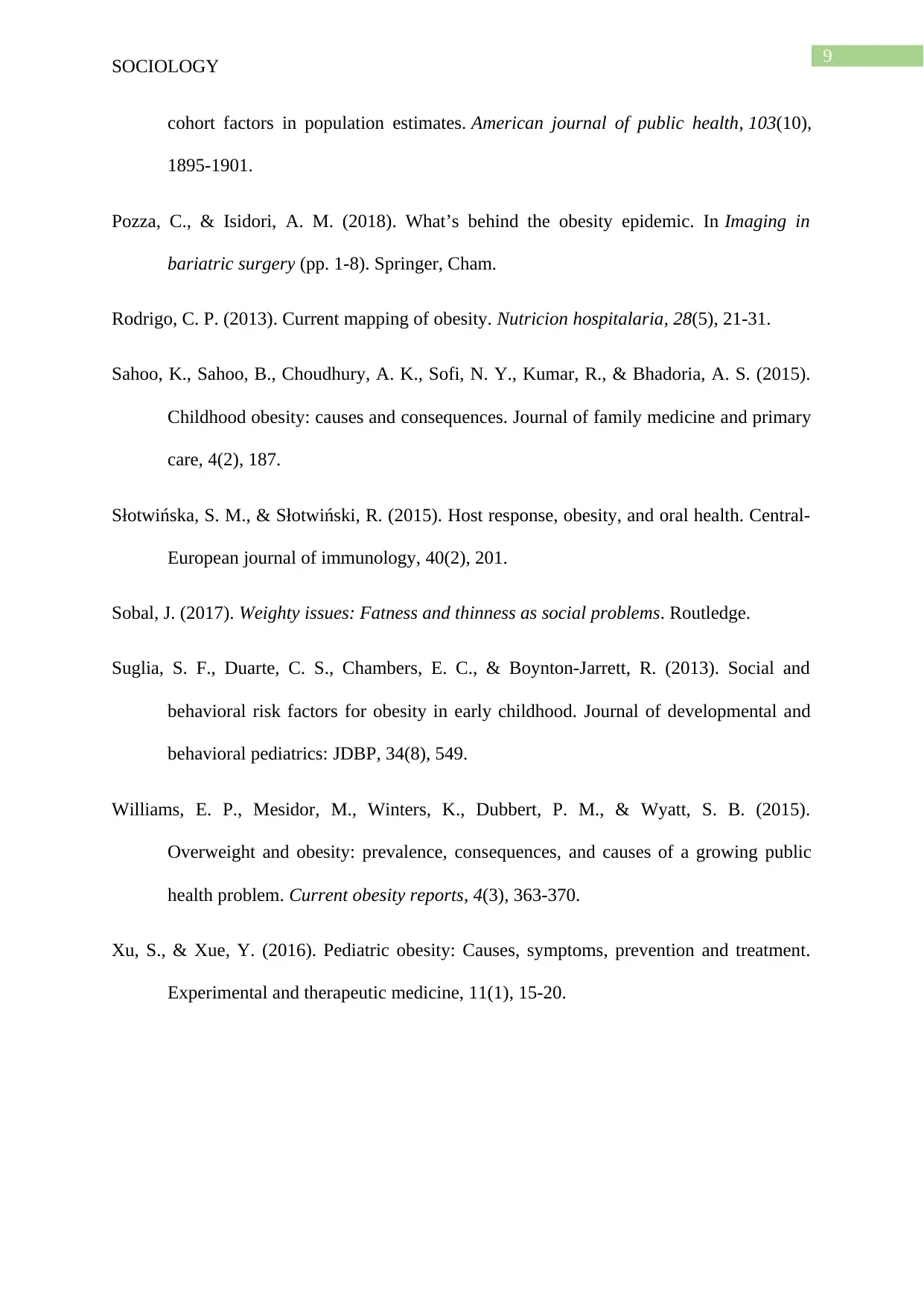
9
SOCIOLOGY
cohort factors in population estimates. American journal of public health, 103(10),
1895-1901.
Pozza, C., & Isidori, A. M. (2018). What’s behind the obesity epidemic. In Imaging in
bariatric surgery (pp. 1-8). Springer, Cham.
Rodrigo, C. P. (2013). Current mapping of obesity. Nutricion hospitalaria, 28(5), 21-31.
Sahoo, K., Sahoo, B., Choudhury, A. K., Sofi, N. Y., Kumar, R., & Bhadoria, A. S. (2015).
Childhood obesity: causes and consequences. Journal of family medicine and primary
care, 4(2), 187.
Słotwińska, S. M., & Słotwiński, R. (2015). Host response, obesity, and oral health. Central-
European journal of immunology, 40(2), 201.
Sobal, J. (2017). Weighty issues: Fatness and thinness as social problems. Routledge.
Suglia, S. F., Duarte, C. S., Chambers, E. C., & Boynton-Jarrett, R. (2013). Social and
behavioral risk factors for obesity in early childhood. Journal of developmental and
behavioral pediatrics: JDBP, 34(8), 549.
Williams, E. P., Mesidor, M., Winters, K., Dubbert, P. M., & Wyatt, S. B. (2015).
Overweight and obesity: prevalence, consequences, and causes of a growing public
health problem. Current obesity reports, 4(3), 363-370.
Xu, S., & Xue, Y. (2016). Pediatric obesity: Causes, symptoms, prevention and treatment.
Experimental and therapeutic medicine, 11(1), 15-20.
SOCIOLOGY
cohort factors in population estimates. American journal of public health, 103(10),
1895-1901.
Pozza, C., & Isidori, A. M. (2018). What’s behind the obesity epidemic. In Imaging in
bariatric surgery (pp. 1-8). Springer, Cham.
Rodrigo, C. P. (2013). Current mapping of obesity. Nutricion hospitalaria, 28(5), 21-31.
Sahoo, K., Sahoo, B., Choudhury, A. K., Sofi, N. Y., Kumar, R., & Bhadoria, A. S. (2015).
Childhood obesity: causes and consequences. Journal of family medicine and primary
care, 4(2), 187.
Słotwińska, S. M., & Słotwiński, R. (2015). Host response, obesity, and oral health. Central-
European journal of immunology, 40(2), 201.
Sobal, J. (2017). Weighty issues: Fatness and thinness as social problems. Routledge.
Suglia, S. F., Duarte, C. S., Chambers, E. C., & Boynton-Jarrett, R. (2013). Social and
behavioral risk factors for obesity in early childhood. Journal of developmental and
behavioral pediatrics: JDBP, 34(8), 549.
Williams, E. P., Mesidor, M., Winters, K., Dubbert, P. M., & Wyatt, S. B. (2015).
Overweight and obesity: prevalence, consequences, and causes of a growing public
health problem. Current obesity reports, 4(3), 363-370.
Xu, S., & Xue, Y. (2016). Pediatric obesity: Causes, symptoms, prevention and treatment.
Experimental and therapeutic medicine, 11(1), 15-20.
1 out of 10
Related Documents
Your All-in-One AI-Powered Toolkit for Academic Success.
+13062052269
info@desklib.com
Available 24*7 on WhatsApp / Email
![[object Object]](/_next/static/media/star-bottom.7253800d.svg)
Unlock your academic potential
Copyright © 2020–2025 A2Z Services. All Rights Reserved. Developed and managed by ZUCOL.





